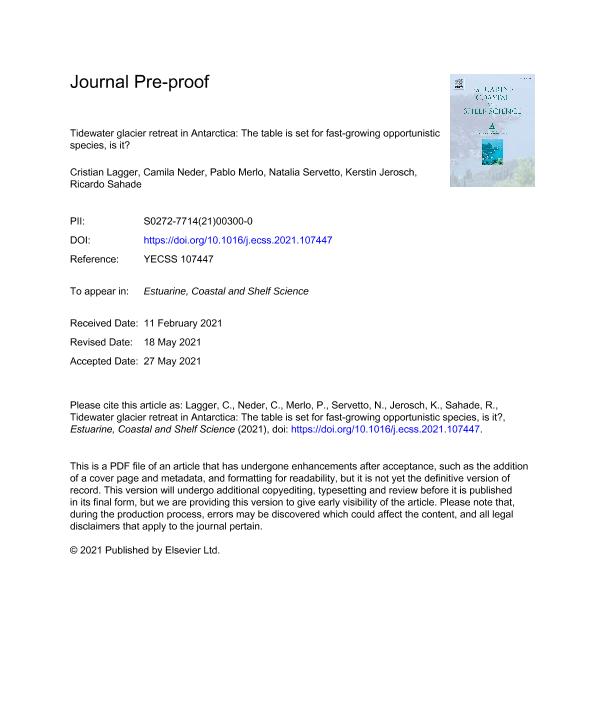Mostrar el registro sencillo del ítem
dc.contributor.author
Lagger, Cristian Fabian

dc.contributor.author
Neder, Camila

dc.contributor.author
Merlo, Pablo Javier

dc.contributor.author
Servetto, Natalia

dc.contributor.author
Jerosch, Kerstin
dc.contributor.author
Sahade, Ricardo Jose

dc.date.available
2022-10-14T16:33:49Z
dc.date.issued
2021-10
dc.identifier.citation
Lagger, Cristian Fabian; Neder, Camila; Merlo, Pablo Javier; Servetto, Natalia; Jerosch, Kerstin; et al.; Tidewater glacier retreat in Antarctica: The table is set for fast-growing opportunistic species, is it?; Academic Press Ltd - Elsevier Science Ltd; Estuarine, Coastal and Shelf Science; 260; 10960015; 10-2021; 1-38
dc.identifier.issn
0272-7714
dc.identifier.uri
http://hdl.handle.net/11336/173286
dc.description.abstract
The rapid warming of the West Antarctic Peninsula (WAP) is causing an important expansion of marine coastal areas due to glacier retreat. These new ice-free areas offer additional habitats for the colonization of benthic species in areas formerly occupied by ice. The establishment of benthic species can represent important negative feedback to the warming process due to the new carbon fixed and stored. Opportunistic, fast-growing, and high turnover species are expected to colonize these new emerging areas. At Potter Cove, the glacier retreat has opened wide areas of soft bottoms, which provides an excellent study area to assess the colonization process and the success of opportunistic species. Here, we examined the population response of the opportunistic soft coral Malacobelemnon daytoni species in the soft bottom area of Potter Cove with different exposure times due to glacier retreat. Our results show a significant variation of M. daytoni population among the sampled areas in terms of presence, abundances, and distribution. In the long-term ice-free areas, opened for more than 60 years, we observed a ~20-fold increase of M. daytoni densities within just 15 years. However, this extraordinary population outburst was not observed in the newer ice-free areas (≤15 years). We registered very low densities in areas of 15 years and no colonies in areas with 10 years of open sea conditions. These were unexpected results based on colonization capabilities showed by the species and habitat suitability of the new areas. Indeed, using Species Distribution Models (SDMs) we also obtained contrasting outputs. SDMs based on long-term areas presence data predicted high habitat suitability and the potential presence of the species in the newer areas. However, when based on newer and older areas data, SDMs showed low habitat suitability and potential absence of the species in the newer areas. This work suggests that species that can be considered as fast and efficient colonizers, could not perform in that way under certain conditions. This deepens the current knowledge on species natural history and environmental relationships, especially to improve our prediction capabilities under changing environmental conditions.
dc.format
application/pdf
dc.language.iso
eng
dc.publisher
Academic Press Ltd - Elsevier Science Ltd

dc.rights
info:eu-repo/semantics/openAccess
dc.rights.uri
https://creativecommons.org/licenses/by-nc-nd/2.5/ar/
dc.subject
ANTARCTICA
dc.subject
BENTHIC ASSEMBLAGES
dc.subject
CLIMATE CHANGE
dc.subject
MALACOBELEMNON DAYTONI
dc.subject
NEWLY ICE-FREE AREAS
dc.subject
SPECIES DISTRIBUTION MODELS
dc.subject.classification
Ecología

dc.subject.classification
Ciencias Biológicas

dc.subject.classification
CIENCIAS NATURALES Y EXACTAS

dc.title
Tidewater glacier retreat in Antarctica: The table is set for fast-growing opportunistic species, is it?
dc.type
info:eu-repo/semantics/article
dc.type
info:ar-repo/semantics/artículo
dc.type
info:eu-repo/semantics/publishedVersion
dc.date.updated
2022-09-07T14:23:40Z
dc.identifier.eissn
1096-0015
dc.journal.volume
260
dc.journal.number
10960015
dc.journal.pagination
1-38
dc.journal.pais
Países Bajos

dc.journal.ciudad
Amsterdam
dc.description.fil
Fil: Lagger, Cristian Fabian. Consejo Nacional de Investigaciones Científicas y Técnicas. Centro Científico Tecnológico Conicet - Córdoba. Instituto de Diversidad y Ecología Animal. Universidad Nacional de Córdoba. Facultad de Ciencias Exactas Físicas y Naturales. Instituto de Diversidad y Ecología Animal; Argentina
dc.description.fil
Fil: Neder, Camila. Consejo Nacional de Investigaciones Científicas y Técnicas. Centro Científico Tecnológico Conicet - Córdoba. Instituto de Diversidad y Ecología Animal. Universidad Nacional de Córdoba. Facultad de Ciencias Exactas Físicas y Naturales. Instituto de Diversidad y Ecología Animal; Argentina
dc.description.fil
Fil: Merlo, Pablo Javier. Consejo Nacional de Investigaciones Científicas y Técnicas. Centro Científico Tecnológico Conicet - Centro Nacional Patagónico. Centro para el Estudio de Sistemas Marinos; Argentina
dc.description.fil
Fil: Servetto, Natalia. Consejo Nacional de Investigaciones Científicas y Técnicas. Centro Científico Tecnológico Conicet - Córdoba. Instituto de Diversidad y Ecología Animal. Universidad Nacional de Córdoba. Facultad de Ciencias Exactas Físicas y Naturales. Instituto de Diversidad y Ecología Animal; Argentina
dc.description.fil
Fil: Jerosch, Kerstin. Alfred-wegener-institut Helmholtz-zentrum Für Polar- Und Meeresforschung; Alemania
dc.description.fil
Fil: Sahade, Ricardo Jose. Consejo Nacional de Investigaciones Científicas y Técnicas. Centro Científico Tecnológico Conicet - Córdoba. Instituto de Diversidad y Ecología Animal. Universidad Nacional de Córdoba. Facultad de Ciencias Exactas Físicas y Naturales. Instituto de Diversidad y Ecología Animal; Argentina
dc.journal.title
Estuarine, Coastal and Shelf Science

dc.relation.alternativeid
info:eu-repo/semantics/altIdentifier/url/https://www.sciencedirect.com/science/article/pii/S0272771421003000
dc.relation.alternativeid
info:eu-repo/semantics/altIdentifier/doi/http://dx.doi.org/10.1016/j.ecss.2021.107447
Archivos asociados
